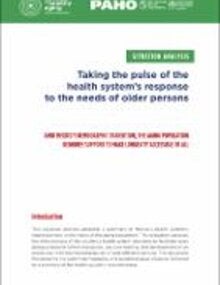This situational analysis aims to present a summary of Mexico’s health system's responsiveness to the needs of its aging population. This evaluation assesses the effectiveness of the country’s health system through available tracer indicators and aims to facilitate an open dialogue towards further evaluation, decision-making, and the development of an action plan with the implementation of cost-effective policies. According to Mexico’s 2020 Housing and Population Census, the total population was 126 million. Of this total, 12% were 60 years or older. By 2050, this older cohort will represent 25% of the total population. In 2015, for the first time, there were more adults 60 years and older than children 0–4 years old. However, the aging process is advancing differentially among states in the country. Adults 60 years and older represent 16% of the total population in Mexico City and the state of Veracruz, while in the states of Baja California Sur, Chiapas and Quintana Roo, older adults represent 10%. Mexico is also undergoing an epidemiologic transition, with noncommunicable disease being most prevalent form of morbidity This situation represents a challenge to the health system and the requirement of adaptation and design of adequate health responses. The Decade of Healthy Aging (2021-2030) encourages countries to adopt the necessary actions to face this situation and to produce data and investigations to inform public policy decisions. In this sense, this document first presents Mexico’s current demographic and epidemiological situation, followed by the main summary of its health system responsiveness, based on the model of health systems monitoring proposed by PAHO to achieve universal care.
|

